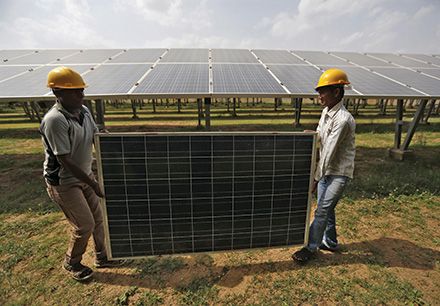As India sets about becoming a leader in clean energy, capital markets are stepping up to the plate to make up for waning bank credit and the lack of a dedicated investor base.
Infrastructure development is climbing up the global political agenda these days as developed economies struggle to stimulate growth and unconventional monetary policy nears its limits. In India, Narendra Modi’s government has placed infrastructure front and centre of its economic policy from day one – and results are emerging as markets respond.
India’s zeal for infrastructure development redoubled following last year’s COP21 climate change agreement. Along with the United States, China and Singapore, it is one of the first countries to ratify the treaty, which aims to curb global warming by holding countries accountable for greenhouse gas emissions.
A formidable task awaits: finance minister Arun Jaitley said in June that India requires infrastructure investment of US$1.5trn-equivalent over the next 10 years, underscoring the need to spread the financing burden.
Commercial banks have traditionally enjoyed a quasi-monopoly over infrastructure financing in India, way ahead of the bond market or foreign competitors. But the dynamic is changing as local lenders recapitalise under pressure from Basel regulations and a growing burden of non-performing loans.
“There is a pressing need for disintermediation away from a reliance on bank financing and a need to decongest the banks which are staring at deteriorating loan quality and balance sheet constraints,” said Rakesh Garg, head of global finance for Barclays in India. “The regulators – SEBI, the MoF and the RBI – are focused on developing the onshore corporate bond market.”
Public-private partnership is the core model for Indian infrastructure development, but meeting the typical 70:30 debt versus equity requirement can be a challenge. Maturity mismatches are a perennial problem for banks given their short-tenor funding base in deposits, while the onshore bond market lacks the liquidity and willingness to support longer tenors, a precondition to the emergence of a flourishing project bond market.
As banks lick their wounds from past infrastructure projects gone sour, institutional investors are taking on a bigger share of debt, driving the debt:equity equation closer to 85:15.
Offshore sovereign wealth funds and specialist green energy funds are also transforming the Indian project finance landscape by accepting a lower internal rate of return on their equity than has been typical – as low as 12%–14% versus the 18%–20% typical in recent years.
The change in sponsor expectations and drive for higher gearing are creating attractive returns for bond investors, often with credit wraps to get deals done.
The template was set as long ago as 2012, when wind power company ReNew Power Ventures raised Rs4bn (US$59.7m) in a six-tranche bond which included a credit-wrapped 10-year tranche guaranteed by state-owned India Infrastructure Finance Co and the Asian Development Bank. The sponsor returned last year in a similar wrapped format with tenors as long as 18 years.
Wind and solar power is at the forefront of infra investment. Its attraction is the six to nine months it takes to build a wind farm or solar plant, versus around four years for a coal-fired power plant. Leverage is also less an issue for renewables than for coal or gas-fired projects, some of which have been blighted by unreliable offtake agreements from power suppliers and coal shortages.
India will become a leading renewable energy producer by 2022 if the Modi government achieves its 100GW solar target, up from 22.5GW today. It is also aiming to increase wind power generation and other sustainable power sources to hit a total of 175GW of renewable energy in the same period.
“The old era of heavily polluting coal-fired power plants is steadily on the wane as India builds its green credentials. Being seen to adhere to COP21 is regarded by Modi as something of a badge of honour,” said the head of debt syndicate at a bank in Hong Kong.
Project and Green bond issuance for infrastructure projects is enjoying a bonanza, although funding is often disintermediated.
“One problem for Green bond issuance in rupee is that there is no dedicated Green investor base onshore in India. That is not to say there is no pent-up interest, and the Indian regulators are moving to motivate the potential Green investor base onshore. Sebi in January produced draft Green bond guidelines as part of this effort,” said Barclays’ Garg.
Meanwhile, Indian banks are increasing their use of long-term bond market financing to support infrastructure lending, Yes Bank, India’s fifth largest private sector bank, issued Rs21.35bn of 10-year infrastructure bonds in early October. The deal unlocked demand across the domestic investor base, from pension, provident and gratuity funds to insurers and pension funds.
In September, HDFC Bank issued Rs66bn of 10-year infrastructure paper. Both banks enjoyed cost savings from the issuance in relation to Reserve Bank of India requirements on reserves and liquidity.
Yes Bank has blazed a trail in India’s nascent Green bond market and last year set a target of mobilising US$5bn in climate-aligned financing via issuance and investment. In late September the bank privately placed Rs3.3bn of seven-year paper – its third issuance in Green bond format – with Dutch development bank FMO. Third party diligence was attached to the deal in ensuring it complies with Green bond principles.
“What we have seen in the Green bond space in India so far is not project-level Green bonds, in that the issuers have been banks which are raising money against a portfolio of renewable assets. So, as such, it is restricted to relatively short tenors, rather than the long tenors – of 12 years and above – which apply in traditional project finance,” said Virendra Dhir, executive director at Standard Chartered in Singapore.
“Nevertheless, even if there is an inherent maturity mismatch, these issuers are enjoying the benefits of investor diversification, which is a welcome market development.”
Given the lack of a green onshore investor base, the job of India’s pioneer Green bond issuers is to target the deep pool of dedicated environmental investors in Europe, particularly Scandinavia, even if that means paying up to meet third-party diligence costs over the life of the bond.
Offshore issuance in G3 currencies is the most likely format, although HDFC’s Green debut in the Masala market in early August proves the offshore rupee is another option.
To see the digital version of this report, please click here
To purchase printed copies or a PDF of this report, please email gloria.balbastro@tr.com



